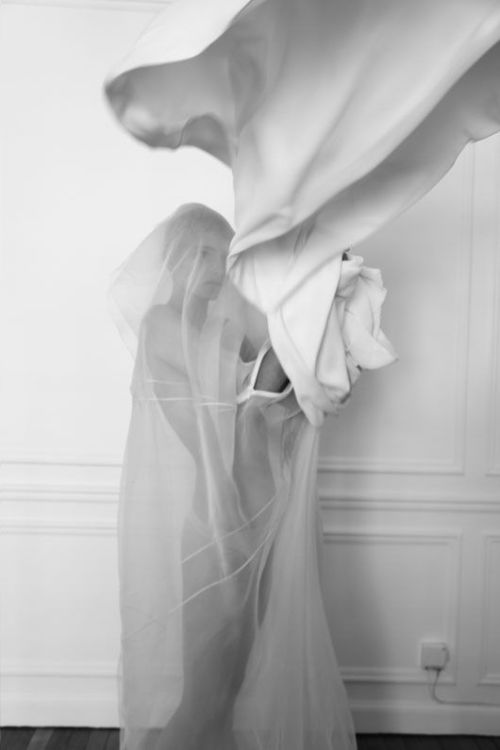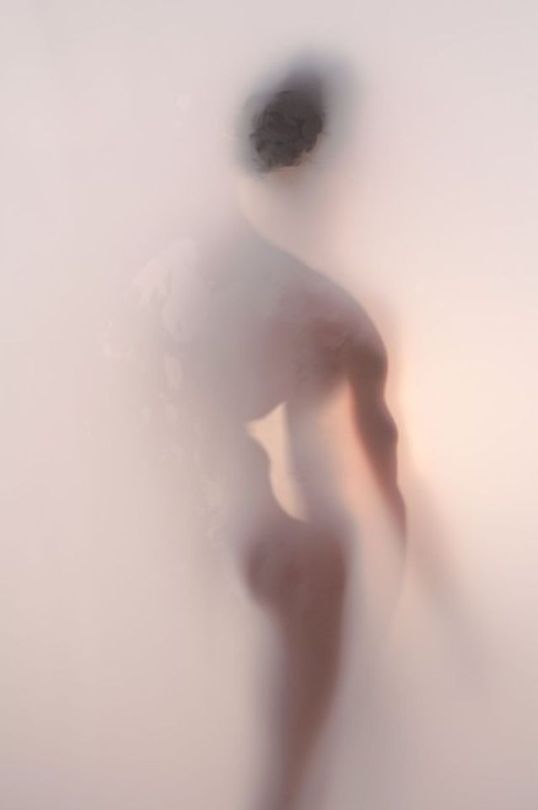485 posts
Hans Haacke - Condensation Cube, 1963-5

hans haacke - condensation cube, 1963-5
“I have partially filled Plexiglas containers of a simple stereometric form with water and have sealed them. The intrusion of light warms the inside of the boxes. Since the inside temperature is always higher that the surrounding temperature, the water enclosed condenses: a delicate veil of drops begins to develop on the inside walls.
At first they are so small that one can distinguish single drops from only a very close distance. The drops grow, hour by hour, small ones combine with larger ones. The speed of growth depends on the intensity and the angle of the intruding light. After a day, a dense cover of clearly defined drops has developed and they all reflect light. With continuing condensation, some drops reach such a size that their weight overcomes the forces of adhesion and they run down along the walls, leaving the trace. This trace starts to grow together again. Weeks after, manifold traces, running side by side, have developed. According to their respective age, they have drops of varying sizes. The process of condensation does not end.
The box has a constantly but slowly changing appearance that never repeats itself. The conditions are comparable to a living organism that reacts in a flexible manner to its surroundings. The image of condensation cannot be precisely predicted. It is changing freely, bound only by statistical limits. I like this freedom.”
-
 livinarchive reblogged this · 1 year ago
livinarchive reblogged this · 1 year ago -
 anothercountrysong reblogged this · 3 years ago
anothercountrysong reblogged this · 3 years ago -
 13engel liked this · 3 years ago
13engel liked this · 3 years ago -
 ghostnaming reblogged this · 3 years ago
ghostnaming reblogged this · 3 years ago -
 mysiette liked this · 4 years ago
mysiette liked this · 4 years ago -
 thebrideofthewind reblogged this · 5 years ago
thebrideofthewind reblogged this · 5 years ago -
 echokomazgeda reblogged this · 5 years ago
echokomazgeda reblogged this · 5 years ago -
 echokomazgeda liked this · 5 years ago
echokomazgeda liked this · 5 years ago -
 avtavr liked this · 6 years ago
avtavr liked this · 6 years ago -
 ancientrune liked this · 6 years ago
ancientrune liked this · 6 years ago -
 pantone548c reblogged this · 6 years ago
pantone548c reblogged this · 6 years ago -
 pantone548c liked this · 6 years ago
pantone548c liked this · 6 years ago -
 theaalphaa reblogged this · 6 years ago
theaalphaa reblogged this · 6 years ago -
 youngprayers reblogged this · 6 years ago
youngprayers reblogged this · 6 years ago -
 deeppaz reblogged this · 6 years ago
deeppaz reblogged this · 6 years ago -
 proditionesamator reblogged this · 6 years ago
proditionesamator reblogged this · 6 years ago -
 iiibooo reblogged this · 6 years ago
iiibooo reblogged this · 6 years ago -
 ymmvor reblogged this · 6 years ago
ymmvor reblogged this · 6 years ago -
 lebadpaps liked this · 7 years ago
lebadpaps liked this · 7 years ago -
 joewardillustration liked this · 7 years ago
joewardillustration liked this · 7 years ago -
 kochaneka reblogged this · 7 years ago
kochaneka reblogged this · 7 years ago -
 nolangerald reblogged this · 7 years ago
nolangerald reblogged this · 7 years ago -
 nolangerald liked this · 7 years ago
nolangerald liked this · 7 years ago -
 greg-a liked this · 7 years ago
greg-a liked this · 7 years ago -
 absurdlakefront liked this · 7 years ago
absurdlakefront liked this · 7 years ago -
 ratak-monodosico reblogged this · 7 years ago
ratak-monodosico reblogged this · 7 years ago -
 painxsr liked this · 7 years ago
painxsr liked this · 7 years ago -
 thesamelucas liked this · 7 years ago
thesamelucas liked this · 7 years ago -
 grippingmarblesteeringwheels reblogged this · 7 years ago
grippingmarblesteeringwheels reblogged this · 7 years ago -
 albumsbyconceptualartists liked this · 7 years ago
albumsbyconceptualartists liked this · 7 years ago -
 dodyet0 liked this · 7 years ago
dodyet0 liked this · 7 years ago -
 elaaph reblogged this · 7 years ago
elaaph reblogged this · 7 years ago -
 drops-of-devotion reblogged this · 7 years ago
drops-of-devotion reblogged this · 7 years ago -
 bloggingaturfuneral liked this · 7 years ago
bloggingaturfuneral liked this · 7 years ago -
 ybarba reblogged this · 7 years ago
ybarba reblogged this · 7 years ago -
 danielfordjohansen liked this · 7 years ago
danielfordjohansen liked this · 7 years ago -
 ami-cienfuegos liked this · 7 years ago
ami-cienfuegos liked this · 7 years ago -
 porgoteo liked this · 7 years ago
porgoteo liked this · 7 years ago -
 sonderrwander liked this · 7 years ago
sonderrwander liked this · 7 years ago
More Posts from Livinarchive

In 1933, Dietrich crossed the Atlantic in the SS Europa making headlines for dressing in a gorgeous white pantsuit. The Parisian police warned her that she would be arrested if she wore menswear in the French capital. In response, Dietrich stepped off the train and onto the Paris platform wearing her most mannish tweed suit, complete with her hair slicked back under a beret and sunglasses fashioned after the monocle, a coded symbol of lesbianism.
Images and text taken from the Dietrich exhibition at the Smithsonian National Portrait Gallery, Washington (x)



